
Telemarketing fraud is a growing problem, costing Americans millions annually. The FTC and FCC are working together to fight back through strict laws, advanced technology, and consumer tools. Here’s a quick summary of their efforts:
- Key Laws:
- Recent Programs:
- Operation Stop Scam Calls: Reduced robocalls in 2024 by targeting fraud networks.
- Project Point of No Entry: Blocks scam calls from entering U.S. networks.
- Consumer Tools:
- Do Not Call Registry: Reduce unwanted calls by registering your number.
- ReportTelemarketer.com: File complaints and get help stopping fraudulent calls.
The agencies also use AI and modern tech to stay ahead of evolving scams, like voice cloning and spoofing. Stay vigilant, report fraud, and protect yourself!
Update on TCPA and New FCC & FTC Rules
Main Telemarketing Laws
The collaboration between the FTC and FCC has led to legal measures that help combat telemarketing fraud effectively.
TCPA Rules and Requirements
The Telephone Consumer Protection Act (TCPA) lays out essential rules for telemarketers, including:
- Calling Hours: Telemarketing calls are allowed only between 8:00 AM and 9:00 PM local time.
- Written Permission: Automated calls and texts require prior written consent from the recipient.
- Caller Identification: Telemarketers must clearly state their name, company, and contact information.
- Do Not Call Registry: Businesses must respect the National Do Not Call Registry and avoid contacting registered numbers.
- Pre-recorded Messages: Strict limitations are placed on the use of pre-recorded messages.
Violating these rules can lead to hefty fines. The Telemarketing Sales Rule (TSR) builds on these protections by introducing stricter regulations for sales practices.
FTC Telemarketing Sales Rule (TSR)
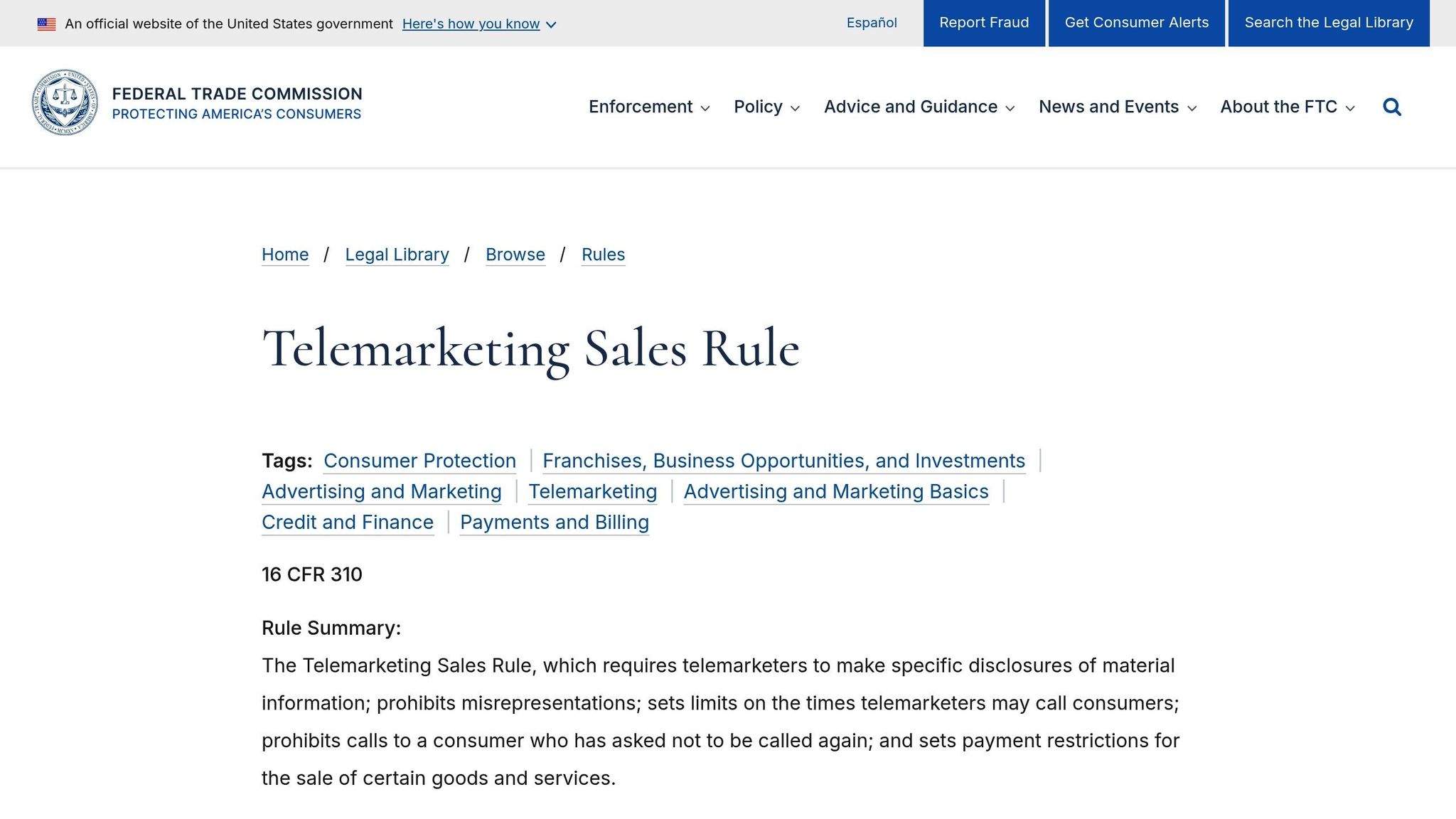
The TSR is designed to protect consumers by enforcing stricter guidelines for telemarketing practices. Some key provisions include:
- Advance Fees: Prohibits accepting upfront fees for debt relief services.
- Transparency: Requires clear disclosure of sales intent, all costs (including restrictions), and no-refund policies.
- Record Keeping: Companies are required to maintain specific telemarketing records.
- Misrepresentation Ban: Misleading claims about goods or services are strictly prohibited.
- Consumer Safeguards: Enforces oversight of sales tactics and payment processes to ensure fair practices.
FCC Rules on Robocalls and Caller ID Spoofing
The FCC focuses on addressing technological abuses in telemarketing, such as robocalls and caller ID spoofing. To combat these issues, the FCC enforces rules that:
- Authenticate Caller IDs: Requires carriers to implement caller ID authentication protocols like STIR/SHAKEN.
- Block Robocalls: Encourages carriers to block unwanted automated calls.
- Ban Caller ID Fraud: Prohibits the use of fake or misleading caller ID information.
- Prevent Evasion: Blocks efforts to bypass call blocking systems.
Consumers can report violations through reliable platforms. Together, these measures and enforcement actions play a critical role in curbing telemarketing fraud.
FTC-FCC Joint Programs
The FTC and FCC have teamed up to strengthen efforts against telemarketing fraud, building on existing TCPA and TSR regulations.
Operation Stop Scam Calls Results
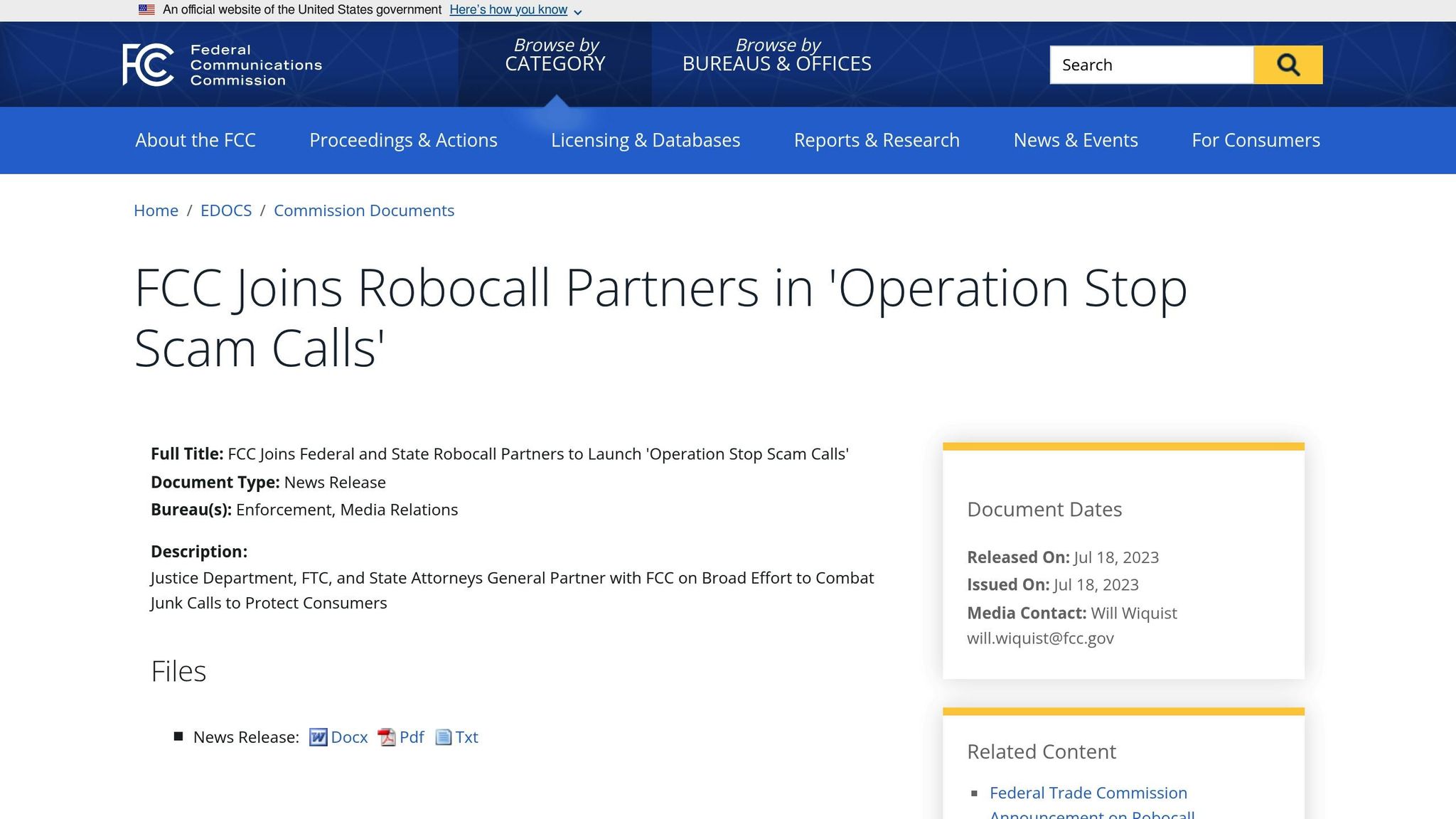
In early 2024, the agencies launched Operation Stop Scam Calls to crack down on illegal robocall schemes. This effort has disrupted fraud networks, penalized offenders, and reduced the number of unwanted calls. The program demonstrates the power of combining enforcement with modern technology to tackle telemarketing fraud.
Project Point of No Entry Goals
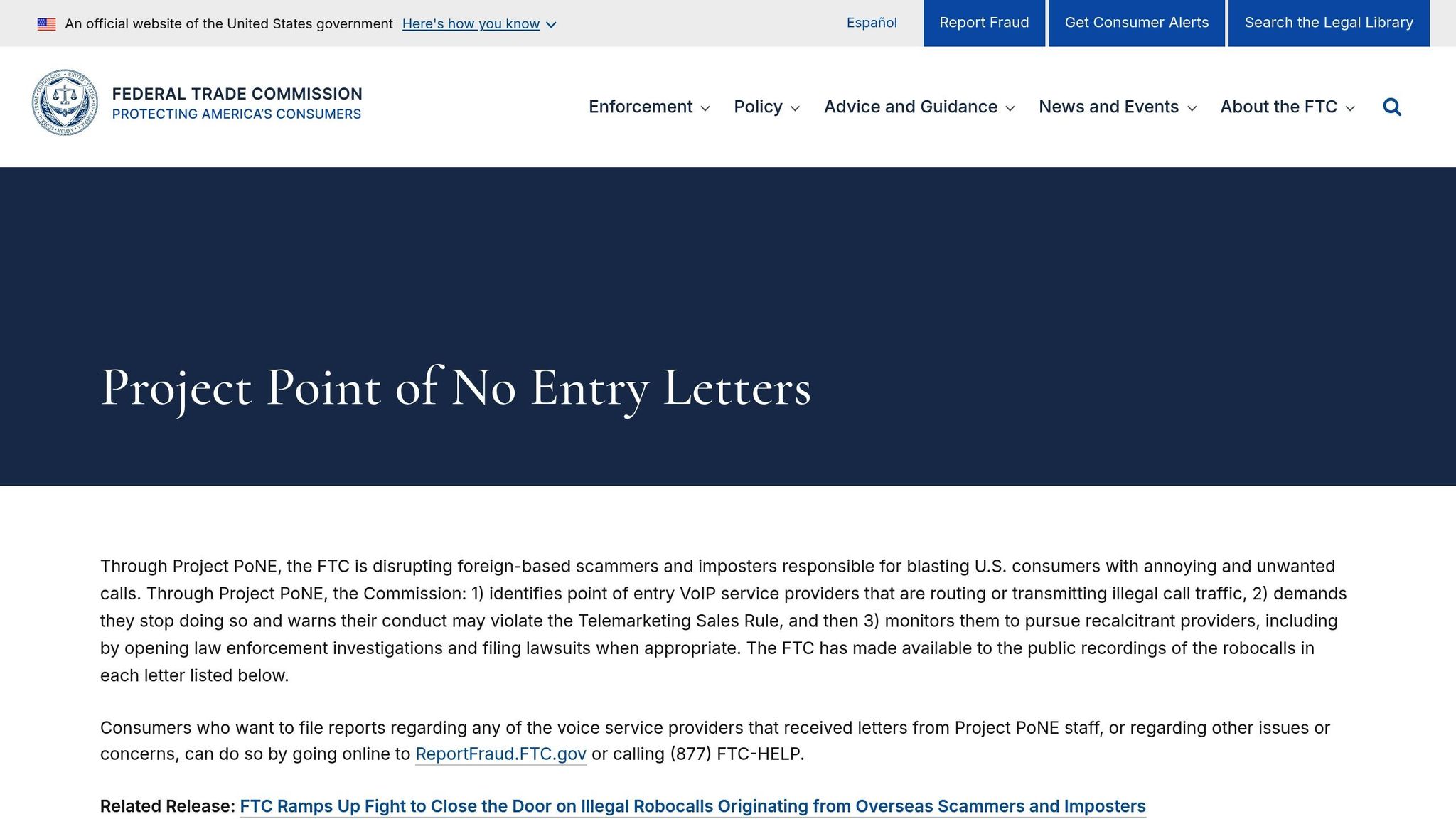
Later in 2024, Project Point of No Entry was introduced to block scammers from infiltrating U.S. telecommunications networks. Key strategies include mandatory call authentication and stricter checks for incoming traffic. The program also emphasizes quick action to shut down scams as they are identified, improving the overall security of telecom systems.
Recent Enforcement Success Stories
The FTC and FCC have successfully taken down fraudulent robocall operations and issued hefty fines to violators. These actions not only deter future scams but also enforce stricter compliance across the industry, showcasing the effectiveness of their collaboration in safeguarding consumers.
sbb-itb-a8d93e1
Consumer Protection Tools
The FTC and FCC have joined forces to create tools that help consumers take action against fraud. These agencies have set up systems to tackle telemarketing scams, working alongside their enforcement efforts to give people the power to fight back.
Using the Do Not Call Registry
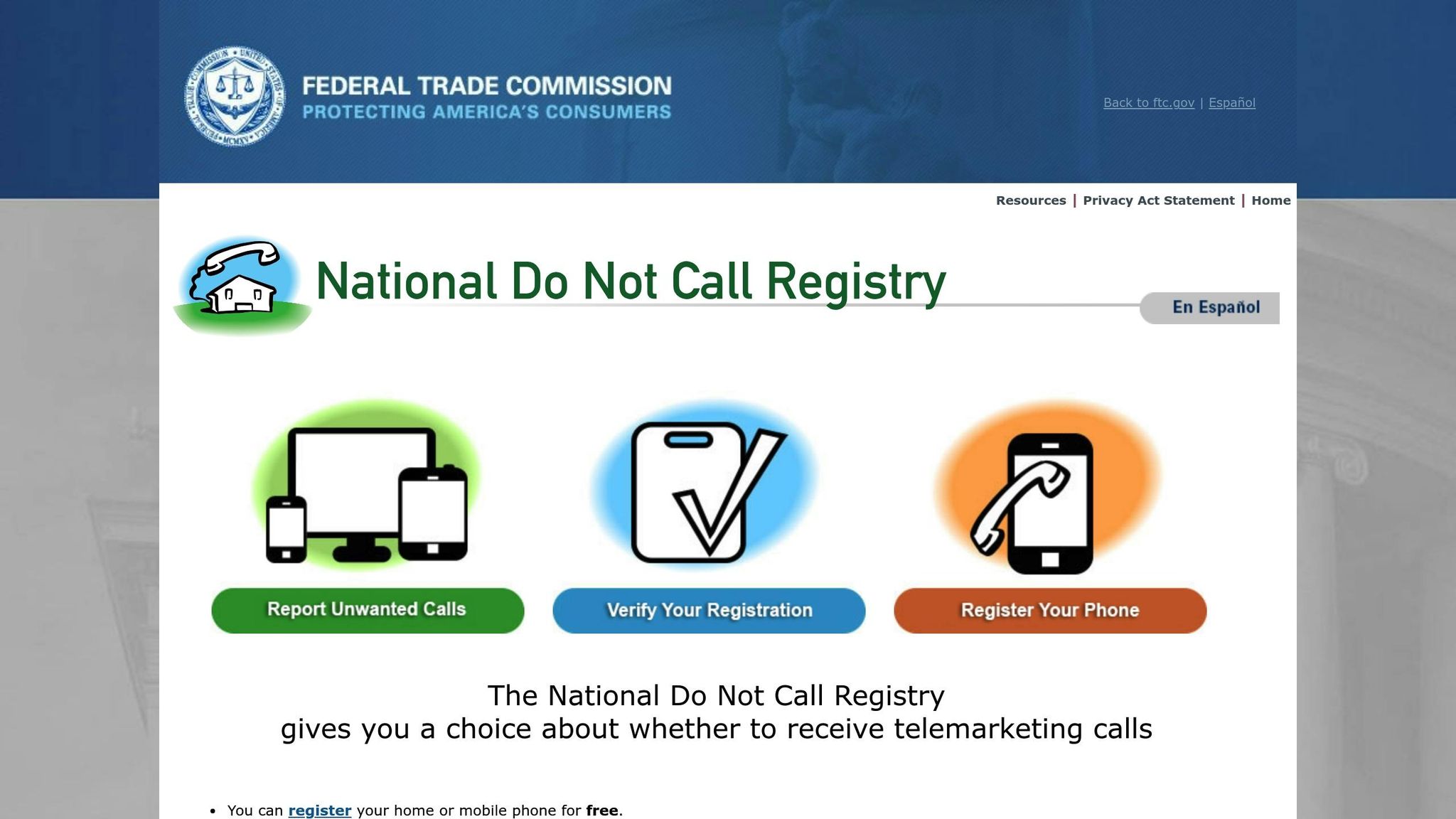
The National Do Not Call Registry is a key resource to reduce unwanted telemarketing calls. While it doesn’t block every call, it helps minimize legitimate telemarketing and flags scammers who disregard the rules.
Here’s how to make the most of the registry:
- Register all your numbers: Add both landline and mobile numbers to the list.
- Keep proof of registration: Save the confirmation email or take a screenshot.
- Allow 31 days for processing: Wait for your registration to take full effect.
- Track unwanted calls: After the 31-day period, note the date, time, and details of any unsolicited calls.
ReportTelemarketer.com Reporting System
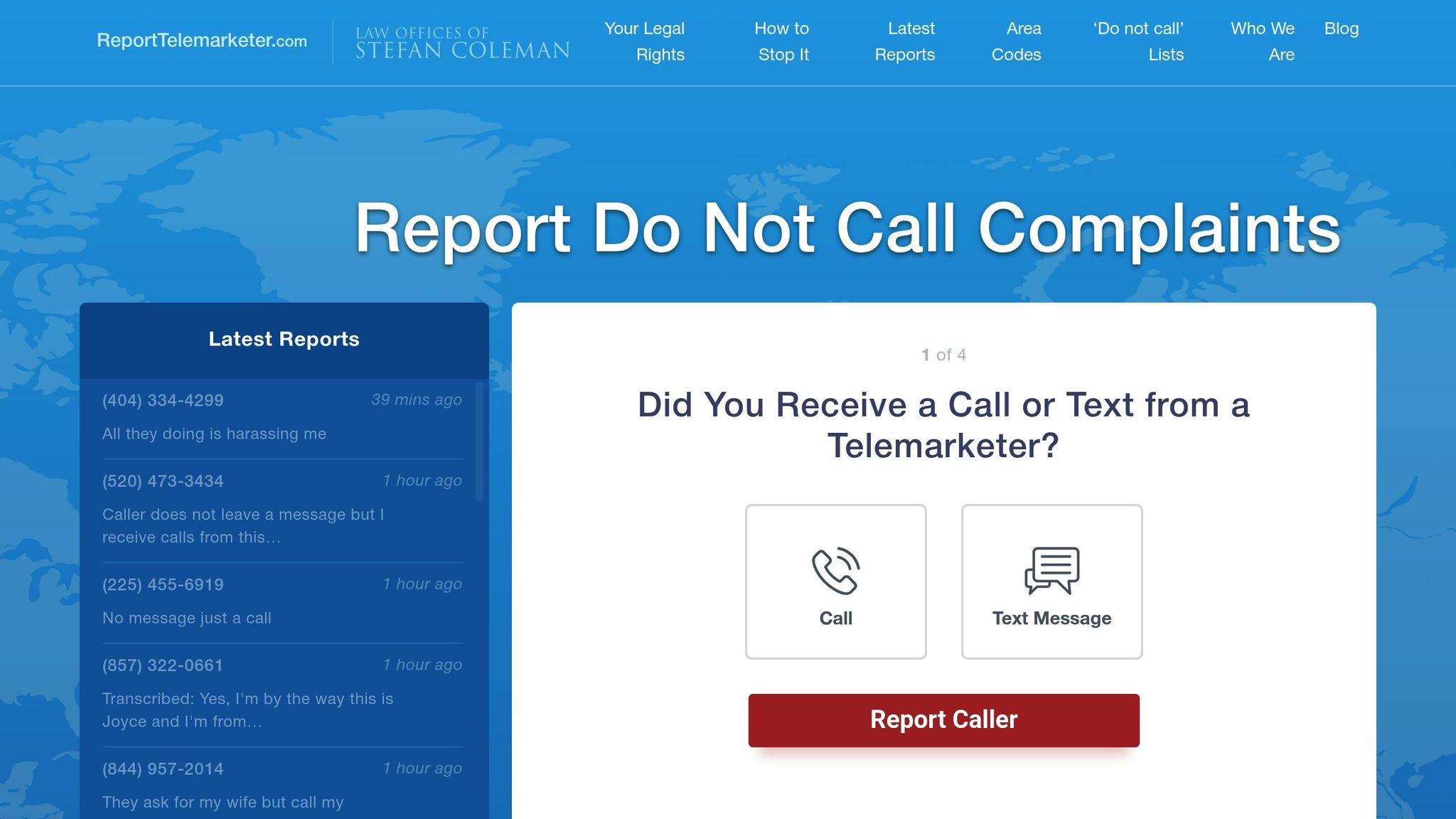
ReportTelemarketer.com is a free service that lets you report unwanted calls and texts. Operated by Coleman, PLLC, this platform investigates complaints and works to stop these communications.
Here’s what the service offers:
- Free investigations using advanced tools to track violations.
- Cease and desist letters sent to offenders when necessary.
- Potential to recover money under consumer protection laws.
- Legal support without upfront fees.
To report a call, provide details like the caller’s number, when they contacted you, and what they were soliciting.
Spotting and Reporting Fraud
Be aware of common signs of fraud:
| Warning Sign | What to Look For |
|---|---|
| Pressure Tactics | Push for immediate decisions or actions. |
| Payment Methods | Demands for wire transfers or gift card payments. |
| Identity Claims | Pretending to be from a government agency. |
| Call Patterns | Frequent calls from different numbers. |
Steps to Protect Yourself:
- Document Everything
Write down details of the call, such as the date, time, phone number, and any claims made. - Report Quickly
Use ReportTelemarketer.com to file a complaint for investigation and follow-up. - Guard Your Information
Never share personal or financial details with unsolicited callers, no matter how convincing they seem.
Future Challenges and Solutions
As regulations improve, fraud tactics continue to evolve, requiring fresh approaches to stay ahead.
AI‑Driven Scam Techniques
AI has opened the door to more advanced telemarketing scams. Tools like voice cloning and deepfake technology allow scammers to impersonate trusted voices and established brands. These criminals also use automated systems and algorithms to make their fraudulent calls more convincing and far-reaching.
Updated Laws and Technological Advances
Regulatory agencies are stepping up their efforts by revising caller verification methods and implementing AI-driven detection systems. The FCC is also exploring new protocols to block unwanted calls and improve verification for international calls.
FTC‑FCC Future Initiatives
Both the FTC and FCC are working on initiatives to tackle telemarketing fraud more effectively:
- Using machine learning to detect and block scam calls earlier
- Advancing call authentication methods to verify call origins with greater accuracy
- Educating consumers on new and emerging scam tactics
In addition, plans are underway to establish a centralized hub for analyzing scam patterns in real time and coordinating swift responses. These efforts aim to significantly enhance the fight against telemarketing fraud.
Summary
The FTC and FCC have joined forces to tackle telemarketing fraud with advanced caller verification systems and AI-driven detection tools. This partnership focuses on staying ahead of fraud tactics through initiatives like Operation Stop Scam Calls and Project Point of No Entry, which aim to strengthen consumer protections.
In addition to enforcement measures, they provide accessible tools for consumers to report scams. For example, ReportTelemarketer.com allows users to file complaints for free, enabling investigations and legal actions against offenders.
Key aspects of their collaboration include:
- Stronger enforcement with improved call authentication systems
- Consumer education to raise awareness of emerging scams
- AI-driven solutions to detect and prevent fraud
- Simplified reporting systems for quicker action against violations